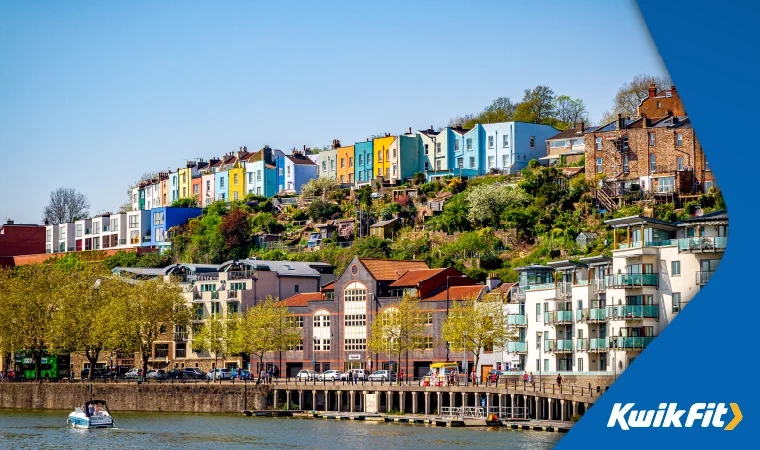A Guide to Driving in Bristol
Jack Dreyer | Monday 16th September 2024 8:00am

Ah, Bristol. A vibrant city offering the perfect blend of rich history and modern attractions to tourists and locals alike. If youíre planning a weekend in Bristol, be sure to put some time aside to mentally prepare for driving and parking as Bristolís roads have amassed quite a reputation in recent yearsÖ
A recent study by The Compensation Experts revealed Bristol to be home to the most dangerous drivers (beating London, Cardiff, and Leeds!), purportedly making Bristol one of the most treacherous places to get behind the wheel.
But donít be put off by this title; in this blog, weíll take you through the ins and outs of driving in Britainís beloved ĎBrizzleí ó from knowing which streets to avoid at rush hour to keeping Clean Air Zone-compliant.
Bristolís motorways
If youíre driving into Bristol from further afield, youíll likely have to encounter one of the many motorways that connect the city to some of the UKís peripherals. Letís take a look at each in turn below.
The M32
Connecting drivers from the M4 directly into the city centre, the M32 is the most direct route for people travelling from the East of England. At just 4.4 miles long, the M32 is one of the shortest motorways in Britain. So, if you find yourself travelling along it, the chances are youíll be taking an exit soon.
The M4
The M4 skirts around the very edge of Bristol as it stretches from London to South Wales, providing an essential link between the capital and the West of the UK.
The M5
Spreading further into the West Country, the M5 runs along the Western edge of the city to connect Bristol to Devon and Cornwall, as well as Birmingham and the Midlands to the North.
City centre roads in Bristol
Owing to its eclectic mix of old, narrow streets and modern infrastructure, driving in Bristolís city centre can be a unique challenge for unseasoned drivers.
The city is known for its steep hills, one-way systems, and numerous pedestrianised areas. So, keep an eye out for the following hotspots when driving (especially during peak times like rush hour, school pick-up times, and bank holiday weekends):
- Roads like Park Street and Baldwin Street often get busy, particularly during peak times, and navigating can be tricky if you're unfamiliar with the layout and the steepness.
- The Centre, often referred to as Bristolís hub, is an open, public space in the middle of a connection point between various major routes, including Anchor Road and Colston Avenue, leading in and out of the heart of the city. Be prepared for heavy traffic here, especially around Queenís Square and the harbourside areas where both locals and tourists converge.
- The A38 and A4044 (Bond Street) are critical routes within the city centre, linking different districts. As such, these roads can become congested.
Itís also worth noting that many roads are lined with cycling lanes and bus lanes, on account of Bristolís increasingly environmentally-friendly policies. As such, you should always keep an eye out for hidden cyclists when turning and double-check your blind spots.
Clifton Suspension Bridge
Arguably the most iconic part of Bristol, the Clifton Suspension Bridge is an architectural feat that has been attracting attention from tourists for decades.
If youíre heading into Bristol, the chances are youíll be driving across the bridge at some point ó and itís a truly unique experience. Combining exquisite views of the Avon Gorge with the impressiveness of the bridge itself, the drive may be short but worth the £1 toll fee for motorists (cyclists and pedestrians go free). While the bridge is open 24/7, during peak times (especially in tourist hotspot season) the bridge can be busy. But, if you stick to the speed restrictions and be mindful of the narrow lanes, youíll be fine.

Where to park in Bristol
Planning to do a bit of sightseeing in the city? Then youíll need to park your motor in a safe space while youíre off taking in the culture. While there is plenty of on-street parking (just be mindful of permitted areas and double yellows), your best bet is to opt for one of the many large-scale car parks:
- Cabot Circus: A central shopping destination with over 2,500 parking spaces. Open 24/7, this car park also offers accessible and family parking spaces alongside EV chargers.
- Temple Meads Station: Located at the train station, this 24/7 car park offers short- and long-term parking for train travellers and commuters, also providing access to bus routes for travelling to surrounding areas.
- Brunel Lock Car Park: If youíre visiting Bristol because you want to see the sights, youíll want to park here. Located right next to the harbourside, the iconic SS Great Britain, and the famous Clifton Suspension Bridge, this small car park is ideal for exploring local landmarks.
Driving laws & regulations in Bristol
There are a number of driving regulations unique to Bristol city centre and the surrounding areas. Letís run through each in turn.
Bristolís Clean Air Zone
In recent years, Bristol has taken significant steps toward reducing its emissions, with the introduction of a Clean Air Zone (CAZ) in parts of the city centre.
Introduced to improve air quality and bring the city in line with regional emissions targets, the CAZ targets high-polluting vehicles travelling into certain parts of the city. This includes the Canonís Marsh area, parts of Hotwells and core streets such as Victoria Street, Hotwell Road, and Queen Square. According to Bristol City Council, over 71% of vehicles travelling into Bristol already meet the zone's emission standards. That being said, the £9 daily charge will not apply to:
- Euro 4, 5 and 6 petrol vehicles, roughly 2006 upwards
- Euro 6 diesel vehicles, roughly end of 2015 onwards
- Fully electric vehicles and hydrogen fuel cell vehicles
- Modified or retrofitted vehicles registered with the Energy Saving Trust's Clean Vehicle Retrofit Accreditation Scheme (CVRAS)
- Motorbikes.
Speed limits in Bristol
In the city centre, a number of speed limits have been put into place to improve pedestrian and cyclist safety, particularly in residential areas. These include central streets such as Baldwin Street and Park Street, certain roads in residential neighbourhoods such as Clifton, Redland, Southville, and Bedminster, and shopping hubs such as Gloucester Road and North Street.
So, keep a close eye on the road signs as, when driving in the busier parts of Bristol, you might suddenly enter a 20 zone without even knowing!

Why not stop at Ö
Now that weíve covered the core laws and super-busy-rush-hour spots to avoid, letís finish with some fun must-sees. If youíre visiting Bristol for a weekend trip, or passing through on your way to Wales or the West Country, consider adding the following places to your itinerary:
- Harbourside: A cultural hub in Bristol with a number of delicious restaurants to dine in.
- Clifton Village: A popular, quaint shopping and dining area.
- Ashton Court: Consider this Bristolís nearby rural retreat, perfect for a countryside escape thatís not too far from the city.
Stay safe on Bristolís roads with Kwik Fit
Regardless of whether youíre visiting from London for a weekend or passing through the city at the start of your holiday to Wales, it pays to familiarise yourself with Bristolís roads.
If you encounter a bump on your journey, donít worry, you're never far from a Kwik Fit. We have a selection of centres in and around Bristol so you can bring your vehicle in.
Whether you're heading on a weekend getaway or navigating Bristolís busy city centre, it's essential to keep your car in top condition. From routine servicing to tyre replacements, the experts at your local Kwik Fit are ready to assist. Why not book an appointment today?
Any facts, figures and prices shown in our blog articles are correct at time of publication.
Featured Articles
Is it Illegal to Drive With One Headlight?
Saturday 19th July 2025
Wondering if itís illegal to drive with one headlight? Learn about the safety risks and penalties of illegal blown bulbs and why you should fix them promptly.
Air Con in EVs & Hybrids: Experts Answer Your Questions
Monday 30th June 2025
Does air con drain EV batteries? Can you use the air con while charging an electric car? Find out the answers to these questions & more from Kwik Fitís experts.
Why Is Your Car Making a Noise? Fixes & Tips
Friday 13th June 2025
When your car starts making unexpected noises, it can certainly be quite disconcerting; it may be nothing to worry about, but hereís what you need to know.









